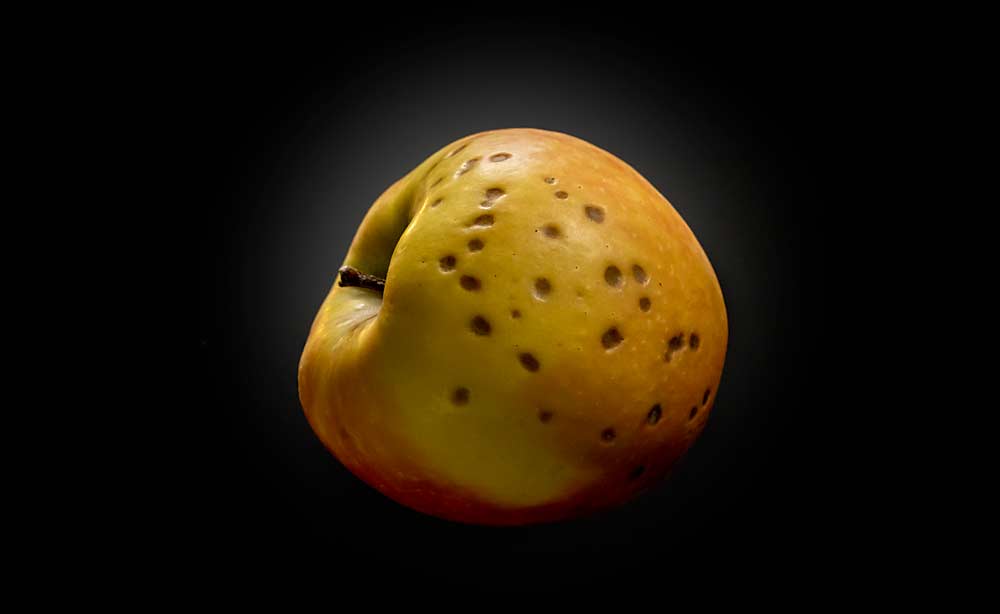
Plant nutrition affects the condition of your orchard, production and fruit quality — thus, the need to apply fertilizers, either through the soil or leaf spray. Nutrient concentration in plant tissues essentially depends upon a plant’s ability to absorb and distribute each nutrient inside the plant.
One of high importance: calcium, which affects numerous physiological processes and fruit quality (Marschner, 2002; Peryea and Neilsen, 2006). Several fruit disorders have been associated with calcium deficiencies, including bitter pit in apples, cork spot in pears and firmness and cracking in cherries.
Unfortunately, increasing the supply of calcium, either through the soil or foliage, far from solves the problem.
Due to the numerous and complex functions of calcium as a nutrient, its distribution and concentration is highly regulated by internal mechanisms of the plant, mainly controlled by the plant’s genetic makeup.

Several horticultural management practices can help maximize the productive potential of the variety; however, one must understand calcium’s function and movement to identify which management practices will be effective in preventing calcium deficiencies.
The form and cellular location of a nutrient is strongly determined by its role, and calcium is particularly complex.
Under its structural role, calcium comprises the cell walls, linked with pectins, ensuring the stability and firmness of plant cells. It can also be found linked to the membrane, keeping cellular integrity. Inside the cells, calcium can be found as a free ion, triggering physiological responses upon binding to specific proteins.
And, the largest amount of calcium is usually found inside organelles, irreversibly bound to insoluble compounds (one example is oxalate). Calcium deficiency disorders have been attributed to either the nutrient’s structural or signaling role.
Generally, soils in Eastern and Central Washington have sufficient calcium for tree fruit demand, though some deficiencies can be found in very sandy soils or weathered soils.
Soil analyses of texture, pH and exchangeable calcium can help to determine calcium availability; calcium levels below 4 meq/100 grams might require additional applications. For more information on adequate soil nutrient levels, visit treefruit.wsu.edu/orchard-management/soils-nutrition.
With adequate calcium levels in the soil, the movement to the roots occurs through mass flow. Nutrients dissolved in the soil solution will travel with the water flux generated by the plant for its transpiration and growth. Nitrogen, magnesium and boron also move mainly by mass flow, while phosphorous and potassium move mainly by diffusion, from high to low concentration, with much lower rates.
In both cases, soil moisture and root volume are fundamental to facilitating nutrient movement and absorption.
Once absorbed by the root, calcium must enter the xylem, the tree’s main conductive system for calcium translocation to aerial tissues. Transport and distribution to the rest of the plant will be driven by transpiration and new growth demand (De Freitas and Mitcham, 2012).
New leaves and shoots have a greater water demand, thus excessive vigor will reduce calcium transport to the fruit.
Green fruits are in active development and can photosynthesize. During this period, approximately four to five weeks after full bloom for apples and three weeks after full bloom for cherries, the maximum demand for cell wall calcium occurs.
That means that ensuring available calcium and promoting early root growth and water movement will benefit calcium absorption and allocation toward the fruit.
However, excessive fruit growth has shown greater incidence of deficiency disorders, possibly due to calcium dilution in the cellular space or the inability of the cell wall and membranes to contain that excessive growth. Thus, fruit size control is fundamental, particularly in susceptible varieties.
In addition, crop load management and water restrictions during the fruit growth phase have been effective in reducing deficiency disorders.
But that is not all. Nutrients can be both antagonistic and synergistic, either at a soil level for nutrient uptake or inside the plant. Calcium is no exception.
At the soil level, calcium competes with other cations: potassium, magnesium, sodium, manganese and ammonium. Even though the mechanism is still unclear, it is recognized that keeping adequate levels of all nutrients in the soil can prevent antagonism. In heavy soils, potassium has low mobility; keeping potassium levels in the range between 150 and 250 mg/kg will prevent antagonism.
Antagonism inside the cell has also been reported. Excessive vigor generally implies high nitrogen levels and, thus, lower nitrogen/calcium relations, while the relationships with potassium and magnesium remain unclear.
According to Amarantes et al. (2011), the best indicator for bitter pit remains total calcium in the fruit peel. Finally, these proportions are not indicative of cause and effect.
For example, shaded fruit experienced calcium deficiency disorders. In preliminary studies, we observed that shaded fruit had less calcium and magnesium and greater amounts of potassium, while exposed fruit had more calcium and magnesium, due to greater water demand.
Higher potassium levels in shaded fruit were associated with an osmotic balance in the absence of the other two nutrients.
Lastly, recent studies have shown that biotic and abiotic stress can affect calcium levels in the membranes and cause calcium deficiency disorders.
Cell membranes contain receptors that perceive external signals triggering calcium movement in and out of the cell. This mechanism might explain why it is possible to induce calcium deficiency disorders in healthy fruit when exposing it to stress conditions.
Therefore, preventing stress conditions can also reduce calcium deficiency disorders.
The complexity of the internal factors that affect calcium dynamics and deficiencies are mostly controlled by the genetics of the variety itself.
In Washington, Honeycrisp is currently the variety most susceptible to calcium deficiency disorders, with production losses reaching as high as 80 percent.
Cheng and Miranda (2018) suggested that Honeycrisp susceptibility is related to its lower fruit transpiration rate. It is likely that rootstock and the combination of variety and rootstock also impact susceptibility.
At the orchard level, management practices can help to minimize calcium deficiency disorders.
Varietal selection: Honeycrisp is a highly susceptible variety. Understand the susceptibility of the variety before planting.
Controlling vigor: Avoid competition for calcium uptake and reduce shade. Under vigorous conditions, reduce nitrogen applications and winter pruning. Summer pruning helps reduce vigor and promote light.
Plant growth regulation: Abscisic acid applications have been effective in increasing fruit calcium and reducing deficiency disorders (DeFreitas, 2011; Falchi et al. 2017).
Pollinization: Seeds attract calcium to the fruit. Good pollination and a high number of seeds per fruit will help reduce deficiency disorders.
Equilibrated nutrient management: Keep adequate levels of nutrients in the soil. Phosphorous, boron and zinc are fundamental for root growth. Avoid excess or toxicity, especially with potassium. Keep potassium range between 150 and 250 mg/kg. Monitor nitrogen levels with foliar analyses and vigor observations.
Root growth: Promote early root growth. Monitor root growth conditions, such as biotic and abiotic stresses, pathogens, excess or deficit water. Avoid management that reduces soil temperature; irrigation for frost protection can reduce soil temperature and delay root growth.
Soil pH between 6.5 and 7.0: Soil pH affects nutrient availability, including those essential for plant growth. Very high pH (greater than 8.0) can precipitate calcium deficiency or indicate salinity problems.
Crop load management: Susceptible varieties should be managed to 5-7 fruits/cm2 trunk cross-sectional area in adult orchards (Robinson et al. 2009).
Water management: Adequate irrigation during initial fruit development is fundamental for calcium uptake into the fruit. Approximately 60 days after full bloom, irrigation can be reduced to avoid excessive fruit growth.
Avoid stress conditions: Stresses can be both abiotic — excess or lack of water, high temperatures, sunburn, wind, etc. — and biotic, such as bacteria and pathogens.
Calcium sprays: The general recommendation is between 0.5 and 1.3 pounds per acre of actual calcium per spray with up to 20 sprays per season. However, the efficacy of calcium sprays has been inconsistent and sometimes contradictory, so applications should be evaluated under each orchard’s condition.
Calcium nutrition, as well as the rest of the plant nutrients, requires an integrated analysis of different factors. Thus, recommendations should be applied according to the limiting factors of the individual orchard and its productive condition. •
Bernadita Sallato is a Washington State University tree fruit extension specialist who can be reached at b.sallato@wsu.edu.
Literature:
Amarante, C. V. T. Ernani, P. R.; Steffens, C. A.; Argenta, L. C. 2011. Skin calcium content is indicative of bitter pit susceptibility in `Fuji´apples. Revista brasileira de Fruticultura 33 (1). 180 – 186.Cheng L. and M. Miranda. 2018. Why Is ‘Honeycrisp’ so Susceptible to Bitter Pit?. New York State Horticultural Society Vol 26, 1.
Cheng, L. and R. Raba. 2009. Nutrient Requirement of Gala/M.26 Apple tree for high yield and quality. Cornell University.
De Freitas, S.T. and Mitcham, E. J. 2012. Factors involved in fruit calcium deficiency disorders. Hort. Rev. 40: 107–146.
De Freitas, S.T., K.A. Shackel, E.J. Mitcham. 2011. Abscisic acid triggers whole-plant and fruit-specific mechanisms to increase fruit calcium uptake and prevent blossom end rot development in tomato fruit. J. Exp. Bot. 62, 2645–2656.
Falchia .R., E. D’Agostin., A. Mattiello., L. Coronica., F. Spinellia., G. Costa and G. Vizzotto. 2017. ABA regulation of calcium-related genes and bitter pit in apple. Postharvest Biology and Technology 132, 1-6.
Franceschi, V. and P. Nakata. 2005. Calcium Oxalate in Plants: Formation and Function. Annual Review Plant Biology 56: 41-71.
Kalcsits, L. G. van der Heijden., M. Reid and K. Mullin. 2017. Calcium absorption during fruit development in ‘Honeycrisp’ apple measured Using 44Ca as a stable Isotope tracer. HortScience 52: 1804 – 1809.
McLaughlin, J.M. and D.W. Greene. 1984. Effects of BA, GA4fl7, and daminozide on fruit set, fruit quality, vegetative growth, flower initiation, and flower quality of ‘Golden Delicious’ apple. J. Am. Soc. Hort. Sci. 109:34–39.
Marschner H. 2002. Mineral Nutrition of Higher Plants. 3rd edition. Academic Press, London, U.K.
Robinson, T. L, S. Lopez, K. Iungerman and G. Reginato. 2009. Crop load management for consistent production of Honeycrisp apples. NY Fruit Q. 17(1): 24–28.






Hi
I am Afaqul I live in Kashmir. This season we have a problem of Scab on apple trees. Can you please recommend any pesticide for that. Nearly 70% 0f apples are damaged by the scab in our whole area.
Hello Afaqul,
We don’t make product recommendations, but here are some articles that have covered apple scab control:
—https://www.goodfruit.com/a-program-for-scab-control/
—https://www.goodfruit.com/how-to-manage-scab-and-mildew/
—https://www.goodfruit.com/kill-the-pathogen/
I hope you find the information helpful.